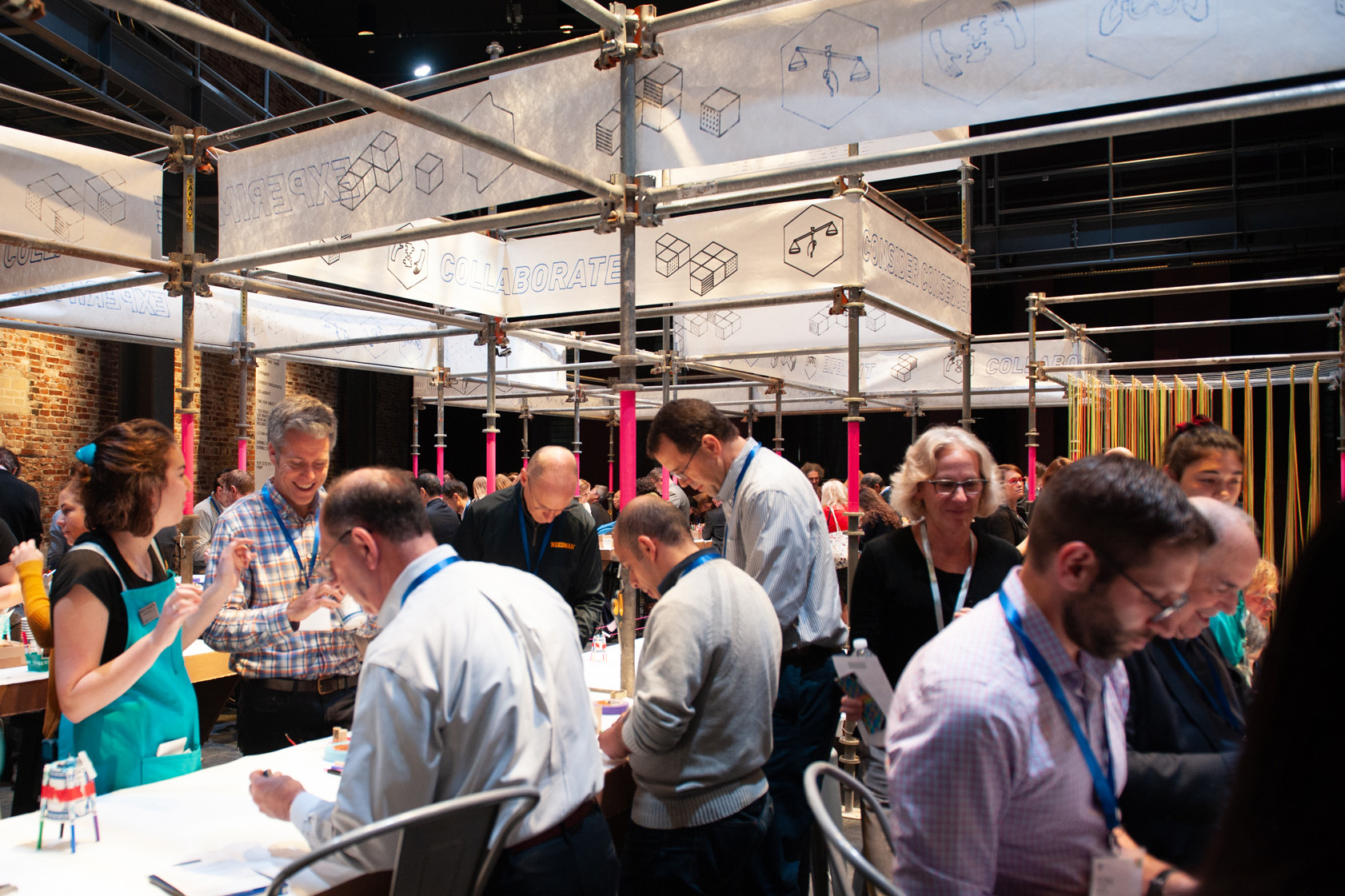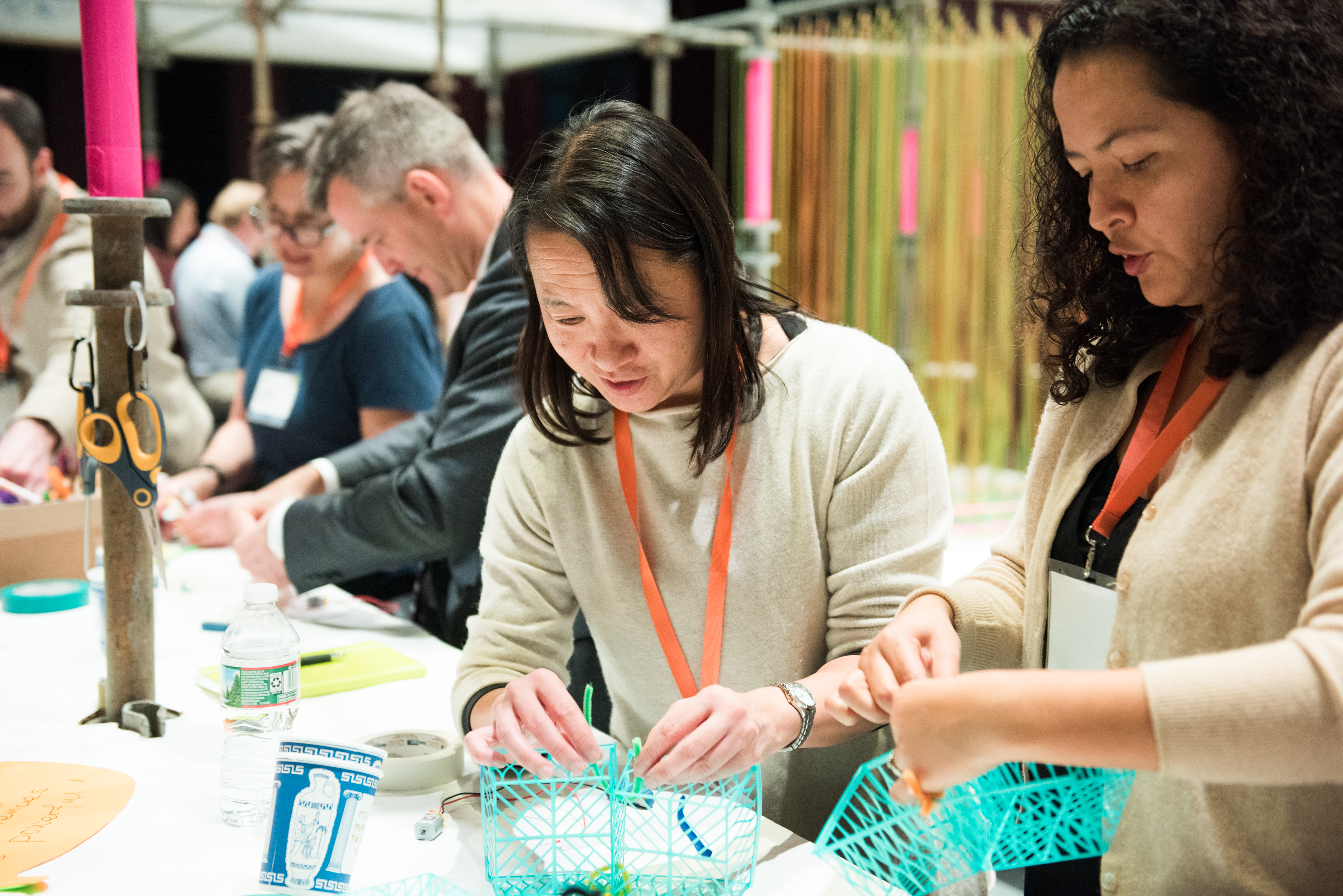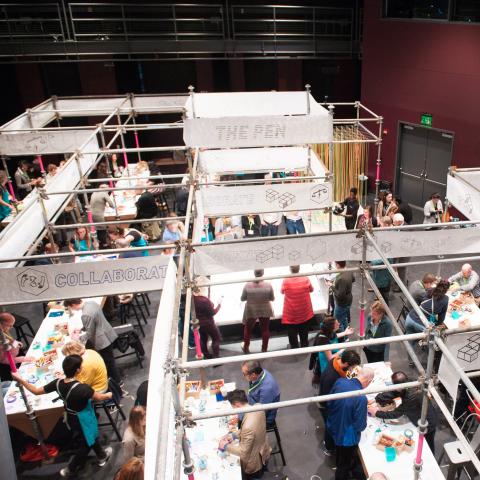A Look Inside the Design Track
 Breaching the two sets of doors separating the Paramount’s Jackie Liebergott Black Box Theatre from the lobby, attendees are greeted by a universe of creativity bounded by a frame of job-site scaffolding. At eye-height, the verticals are softened with pink tape. Below, burley cardboard tables are set into the cross-beams. In one cube, a field of brightly-colored surgical tubing is suspended from above. In another, a blank white canvas in the spotlight. A dreamy, ephemeral soundtrack completes the scene, more ‘Wonderland’ than Education Conference.
Breaching the two sets of doors separating the Paramount’s Jackie Liebergott Black Box Theatre from the lobby, attendees are greeted by a universe of creativity bounded by a frame of job-site scaffolding. At eye-height, the verticals are softened with pink tape. Below, burley cardboard tables are set into the cross-beams. In one cube, a field of brightly-colored surgical tubing is suspended from above. In another, a blank white canvas in the spotlight. A dreamy, ephemeral soundtrack completes the scene, more ‘Wonderland’ than Education Conference.
Student hosts in hand-sewn teal aprons direct the incoming crowds. “Come on in, find a seat!” at the dozen or so tables — each packed with a mix of craft supplies, electric motors, and helmed by another teal-clad student. En route, some entrants detour through The Squiggler, a 144-tenticaled creature of surgical tubing and ink, whose Crayola fingers trace the path of each entrant, creating a rainbow shadow pattern on the paper they walk over.
Once the crowd settled in, the host, Olin student Sara Ballantyne, launches us into Part I: Experiment and Collaborate, creating drawing machines with “bodies of paper or plastic, legs of markers, and the heart of it all, a motor whose rhythm comes from an offset mass on its top.”
Working in teams comprised of college professors, industry professionals, undergraduate students, and many others, the anticipatory cacophony of the room quiets down and is replaced by the sounds of paper being cut, duct tape being ripped, and markers being un-capped. As the minutes pass, the creatures come to life, accompanied with gleeful cheers. Once they’re up and running, the creatures are transported to ‘The Pen’, a miniature spot-lit ring where each is set free to express its own mechanically-enabled artistic vision. 
“Our intention was for you to feel what it means to experiment and collaborate,” The host explains afterwards, leading into a brief, structured reflection on the emotional experience of the activity and what role emotion might play in design work more broadly, from mechanical engineering to educational systems.
As student guides pull colored trapezoids out of their pockets, so begins Part II: Consider Consequences. With the help of “a highly technological Artificial Consequence Engine, A.C.E. for short” (a.k.a a folded paper fortune-teller), participants are charged to consider the consequences of macro design trends – Smart Cities, the future of Artificial Intelligence, etc. – while A.C.E. provokes: “What would your grandma say?” and “Confront privilege,” and “Who wins and who loses?”
 A.C.E. scaffolds tangible dimensions along which we may consider the ethics and consequences of emergent technologies, beginning the critical dialogue missing from much STEM’s tech-utopianism.
A.C.E. scaffolds tangible dimensions along which we may consider the ethics and consequences of emergent technologies, beginning the critical dialogue missing from much STEM’s tech-utopianism.
Behind this experience lies a whole other story. The Design experience was created by a 12-student, two-month-long educational experience at Olin, scaffolded by several faculty and staff members. It was a marathon of design, iteration and production:
-
20 uniquely-pocketed teal aprons
-
200 linear ft of banners, printed by Harry Plotter, a custom-built printer
-
18 milled cardboard tables (recycleable!)
-
54 milled cardboard storage boxes
-
144 rubber water-filled hosed Crayola marker suspenders, a.k.a the Squiggler
-
184 pieces of scaffolding
Universes of alternate ideas, prototypes, and activities left on the cutting room floor.
 Breaching the two sets of doors separating the Paramount’s Jackie Liebergott Black Box Theatre from the lobby, attendees are greeted by a universe of creativity bounded by a frame of job-site scaffolding. At eye-height, the verticals are softened with pink tape. Below, burley cardboard tables are set into the cross-beams. In one cube, a field of brightly-colored surgical tubing is suspended from above. In another, a blank white canvas in the spotlight. A dreamy, ephemeral soundtrack completes the scene, more ‘Wonderland’ than Education Conference.
Breaching the two sets of doors separating the Paramount’s Jackie Liebergott Black Box Theatre from the lobby, attendees are greeted by a universe of creativity bounded by a frame of job-site scaffolding. At eye-height, the verticals are softened with pink tape. Below, burley cardboard tables are set into the cross-beams. In one cube, a field of brightly-colored surgical tubing is suspended from above. In another, a blank white canvas in the spotlight. A dreamy, ephemeral soundtrack completes the scene, more ‘Wonderland’ than Education Conference.
 A.C.E. scaffolds tangible dimensions along which we may consider the ethics and consequences of emergent technologies, beginning the critical dialogue missing from much STEM’s tech-utopianism.
A.C.E. scaffolds tangible dimensions along which we may consider the ethics and consequences of emergent technologies, beginning the critical dialogue missing from much STEM’s tech-utopianism. 20 uniquely-pocketed teal aprons
200 linear ft of banners, printed by Harry Plotter, a custom-built printer
18 milled cardboard tables (recycleable!)
54 milled cardboard storage boxes
144 rubber water-filled hosed Crayola marker suspenders, a.k.a the Squiggler
184 pieces of scaffolding
Design Testimonial
“I loved that this taught me to monitor my emotional experience at the same time as I monitored my technical “prowess” (which was limited). The combination of the head and the heart made for a powerful understanding of the value of both in what would typically be considered a heady experience. This cemented the day for me right out of the gate.”
